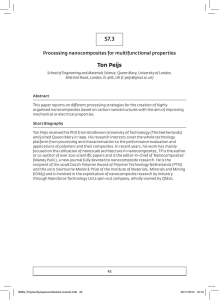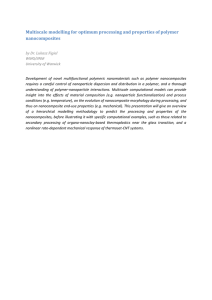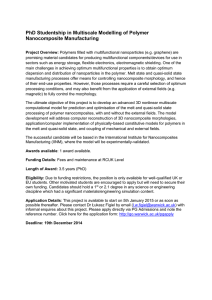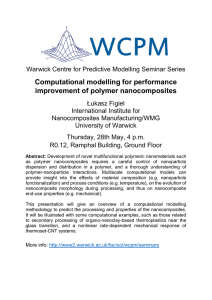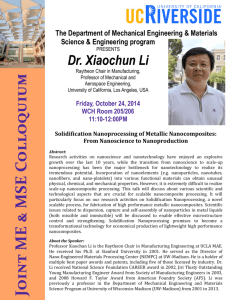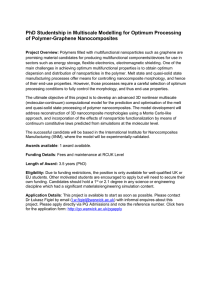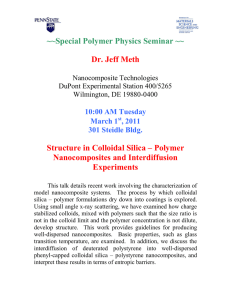Document 14258016
advertisement
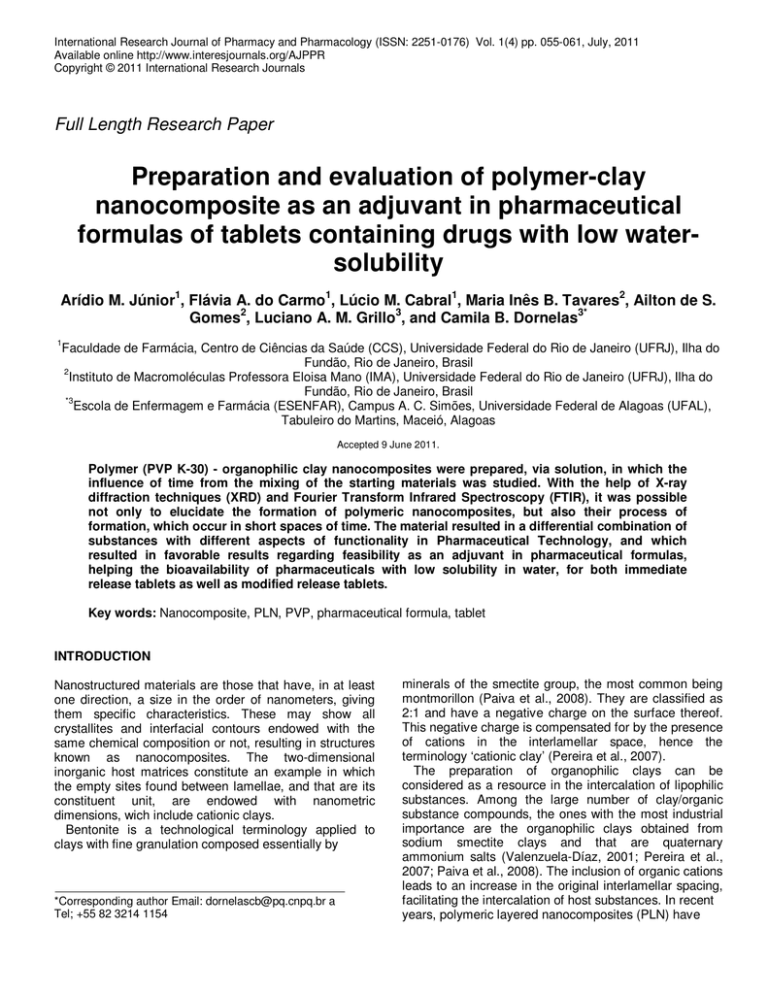
International Research Journal of Pharmacy and Pharmacology (ISSN: 2251-0176) Vol. 1(4) pp. 055-061, July, 2011 Available online http://www.interesjournals.org/AJPPR Copyright © 2011 International Research Journals Full Length Research Paper Preparation and evaluation of polymer-clay nanocomposite as an adjuvant in pharmaceutical formulas of tablets containing drugs with low watersolubility Arídio M. Júnior1, Flávia A. do Carmo1, Lúcio M. Cabral1, Maria Inês B. Tavares2, Ailton de S. Gomes2, Luciano A. M. Grillo3, and Camila B. Dornelas3* 1 Faculdade de Farmácia, Centro de Ciências da Saúde (CCS), Universidade Federal do Rio de Janeiro (UFRJ), Ilha do Fundão, Rio de Janeiro, Brasil 2 Instituto de Macromoléculas Professora Eloisa Mano (IMA), Universidade Federal do Rio de Janeiro (UFRJ), Ilha do Fundão, Rio de Janeiro, Brasil *3 Escola de Enfermagem e Farmácia (ESENFAR), Campus A. C. Simões, Universidade Federal de Alagoas (UFAL), Tabuleiro do Martins, Maceió, Alagoas Accepted 9 June 2011. Polymer (PVP K-30) - organophilic clay nanocomposites were prepared, via solution, in which the influence of time from the mixing of the starting materials was studied. With the help of X-ray diffraction techniques (XRD) and Fourier Transform Infrared Spectroscopy (FTIR), it was possible not only to elucidate the formation of polymeric nanocomposites, but also their process of formation, which occur in short spaces of time. The material resulted in a differential combination of substances with different aspects of functionality in Pharmaceutical Technology, and which resulted in favorable results regarding feasibility as an adjuvant in pharmaceutical formulas, helping the bioavailability of pharmaceuticals with low solubility in water, for both immediate release tablets as well as modified release tablets. Key words: Nanocomposite, PLN, PVP, pharmaceutical formula, tablet INTRODUCTION Nanostructured materials are those that have, in at least one direction, a size in the order of nanometers, giving them specific characteristics. These may show all crystallites and interfacial contours endowed with the same chemical composition or not, resulting in structures known as nanocomposites. The two-dimensional inorganic host matrices constitute an example in which the empty sites found between lamellae, and that are its constituent unit, are endowed with nanometric dimensions, wich include cationic clays. Bentonite is a technological terminology applied to clays with fine granulation composed essentially by *Corresponding author Email: dornelascb@pq.cnpq.br a Tel; +55 82 3214 1154 minerals of the smectite group, the most common being montmorillon (Paiva et al., 2008). They are classified as 2:1 and have a negative charge on the surface thereof. This negative charge is compensated for by the presence of cations in the interlamellar space, hence the terminology ‘cationic clay’ (Pereira et al., 2007). The preparation of organophilic clays can be considered as a resource in the intercalation of lipophilic substances. Among the large number of clay/organic substance compounds, the ones with the most industrial importance are the organophilic clays obtained from sodium smectite clays and that are quaternary ammonium salts (Valenzuela-Díaz, 2001; Pereira et al., 2007; Paiva et al., 2008). The inclusion of organic cations leads to an increase in the original interlamellar spacing, facilitating the intercalation of host substances. In recent years, polymeric layered nanocomposites (PLN) have Int. Res. J. Pharm. Pharmacol. 056 emerged as a revolutionary new class of materials, by demonstrating an increase in a number of properties, which explains their growing attraction in the academic and industrial fields (Lagashetty and Venkataraman, 2005). Among the existing pharmaceutical forms, tablets feature mostly in the world scene (Viçosa et al., 2009). As with any pharmaceutical form, the active ingredient is that which confers the applicability of it, therefore they are the adjuvants that will guarantee the existence of the tablet as the pharmaceutical form. There are several classes of adjuvants, but there is one in particular which has great importance to be directly involved with bioavailability of the drug, the dissolution promoters (Viçosa et al., 2009). Bioavailability is the parameter that deals with the arrival of the drug to its active site, and this will depend on a series of physical and chemical characteristics of the drug, but that can be adjusted to suit the pharmaceutical formulation (Van Savage and Rhodes, 1995; Viçosa et al., 2009). Thus, for a biologically active molecule to be pharmacologically usable in the treatment of pathology, it must be dissolved in aqueous biological fluids for absorption and interaction with its target site. In solid pharmaceutical forms this means that the drug should be dissolved to pass through the biological membrane of the gastrointestinal tract, meaning that processes such as desegregation, disintegration and dissolution should occur in a definitive way starting from the administration of the tablet. Consequently, substances that are poorly soluble in water, or class II in the Biopharmaceutical Classification (Amidon et al., 1995), imply limitations with regard to their therapeutic application. Consequently, they are the main target of study in Pharmaceutical Technology. Various substances can act as dissolution promoters in distinct ways, but all with the aim of increasing the solubility of the drug. Among these, are included the silicates, the surfactants and hydrophilic polymers. Phyllosilicates that are said to be expansive, such as bentonite, receive this designation to their capacity for the adsorption of water in the interlamellar space, resulting in viscous and thixotropic dispersions (Amorim et al., 2006; Botelho, 2006). Organophilic clays have shown elevated swelling in specific organic fluids, and forming gels in organic solutions (Valenzuela-Díaz, 2001). Surfactants are widely used due to their amphoteric nature, and therefore able to reduce the interfacial tension, helping to promote solubility. Hydrophilic polymers act on the crystal structure of the drug, probably through a weak drugpromoter interaction, owing to the chemical nature of the polymers. The possible breakdown of crystallinity, combined with a maximization of the porous structure of a water soluble polymer matrix could justify the increased solubility of these crystalline substances poorly soluble in aqueous media (Viçosa et al., 2009). The phenomenon described occurs in the presence of small amounts of the substance. The usual concentration is variable, depending on the substance used, such as 0.5-5% in the case of croscarmellose sodium and 8.2% for sodium starch glycolate for example (Kibbe, 2000). When the chosen substance is said to be formed by the matrix and when it is in its greatest amount (between 15 and 40% for poloxamer 407, and from 10 to 80% for hydroxypropyl methylcelulose, for example), it has the capacity to modulate drug release (Kibbe, 2000). The concept of a matrix implies a mechanism of controlled release in models of modified release drug forms. In this case, the hydration of the polymer, the same one formerly employed as a dissolution promoter, in the form of a gel, will be the limiting factor for drug release, and justifying the differentiation in drug release (Viçosa et al., 2009). current study, therefore, intended to combine three different classes already with an established use in Pharmaceutical Technology: silicate, surfactant and hydrophilic polymer into a single material. As such, we decided to investigate the formation of a PLN organoclay (oc) – polymer (p): bentonite (silicate) organically modified with octadecylamine salt (surfactant), named viscogel B8, and polyvinyl pyrrolidone, PVP K-30 (polymer). MATERIALS AND METHODS MATERIALS Microcrystalline cellulose PH 200 (Avicel®), FMC; Croscarmellose sodium (AcDiSol®), FMC; Dapsone, GEMINI EXPORTEX, colloidal silicon dioxide (Aerosil® 200), DEGUSA, magnesium stearate, FARMOS; Hydroxypropyl methylcelulose (HPMC), SIGMA; Lactose (Cellactose 80®), FARMOS; sodium lauryl sulfate, Merck; Methyldopa, FARMEX; PVP K-30, SIGMA; viscogel B8® (bentonite modified with octadecylamine salt), BENTEC. Dichloromethane, TEDIA. In all prepared solutions used for the measurement of the active principle by UV spectroscopy and in dissolution assays, freshly distilled water was used. Simulated gastric fluid (SGF) was prepared as per textbook (USP-27). METHODS Preparation of nanocomposites Viscogel B8 - PVP K-30 nanocomposites were prepared by a solution intercalation method (Ray; Okamoto, 2003) in dichloromethane at room temperature. In these tests, the effects of variance over time (15, 30, 45 minutes, 1, 24, 48 and 72 hours) were tested. The dispersions were brought to the rotary evaporator to remove the solvent. The product of evaporation was then pulverized and calibrated for particle size. Junior et al. 057 Characterization of nanocomposites X Ray Diffraction (XRD) A Rigaku X-ray diffractometer, model Miniflex was used, operated at 40 kV and 30 mA, 0.05, at room temperature. CuKα radiation was used as the X-ray source, with a wavelength of 0.15418 nm. To measure the basal spacing, the Bragg equation was applied. Pure viscogel B8 was used for comparative purposes in order to corroborate the formation of nanocomposites. However, there was also a dispersion of viscogel B8 with solvent only (”blank”) to evaluate the possible effect of solvent only on its structure (Burgentzlé et al., 2004). lauryl sulfate (surfactant) and PVP K-30 (polymer) were tested. Also, tablets were prepared without the dissolution promoter as the “blank”. Dapsone tablets were produced by direct compression, containing in addition to the active ingredient: 1.5% magnesium stearate, 30% of the substance to be tested and lactose q.s.p. Besides the nanocomposite, hydroxypropylmethylcellulose (HPMC), classic retardant matrix, and the physical mixture of PVP K-30 and viscogel B8 were evaluated. All tablets were prepared in an eccentric compressor, Stokes brand. Characterization of tablets Fourier Transform Infrared Spectroscopy (FTIR) In vitro release studies Fourier transform infrared spectroscopy measurements in the 4000–400 cm−1 range were performed in a Perkin– Elmer spectrometer, model 1720-X, utilizing the pellet (press-disk) technique. Samples (nanocomposites obtained and their starting materials) were dispersed in dry KBr (2:100 mg), and the mixture was ground to fine particles in a mortar and then pressed to form pellets. All the tablets were evaluated using the dissolution test (FARM. BRAS., 1988). The paddle apparatus II was used to conduct the tests at a temperature of 37 °C in 900 mL of dissolution medium (SGF) in a New Ethics dissolutor, model 399. The percent dissolution by methyldopa in SGF was quantified by UV-Vis spectrophotometry (λ = 280 nm) at the final time of 120 minutes. The percent dissolution of dapsone in SGS was monitored by UV-Vis spectrophotometry (λ = 290 nm) for 120 minutes, with removal of aliquots at regular intervals of 10 minutes. Calibration curves of the drugs were previously developed. A Perkin-Elmer spectrophotometer, 734 UVVis was used. The experiments were performed in triplicate. Test to determine toxicity to 10 g/kg of body weight In a group of 10 Swiss mice, weighing 20 g (± 2 g), a dose of 10 g/kg of the product of viscogel B8, per body weight of the animal, was diluted in 300 µL of water, and administered orally through a cannula. The animals were observed for 14 days. A control group was used. The tests were performed according to the official compendium (Farm. Bras., 1988). RESULTS Characterization of the nanocomposites Preparation of tablet formulas To evaluate the performance of new nanomaterials as adjuvants, two basic formulas were developed: the first with methyldopa 250 mg, for the evaluation of the nanocomposite as a promoter of flow in immediate release tablets; the other with 100 mg of dapsone, for the evaluation of the nanocomposite as an adjuvant in modified release tablets. Methyldopa is a centrally acting antihypertensive and dapsone is the drug of choice for treatment of leprosy. Both are active for class II in the Biopharmaceutical Classification System. Methyldopa tablets were wet produced, containing, in addition to the drug: 37.5% lactose and 19% microcrystalline cellulose (internal phase), 3% croscarmellose sodium, 1% magnesium stearate, 0.5% colloidal silicon dioxide and 0.5% of the dissolution promoter to be tested (external phase). Besides the nanocomposite, colloidal silicon dioxide (silicate), sodium Basal spacing values were calculated from the XRD patterns obtained from the products of viscogel B8 (oc) PVP K30 (p) at different reaction times (15 min, 30 min, 45 min, 1 hr, 24 hrs, 48 hrs and 72 hrs) in dichloromethane at room temperature by rotary evaporator, without prior swelling and shown in the following table. XRD spectras can be checked by the figure 1-a. Figure 1-b illustrates XRD spectra of oc “blank” in compared with pure oc (powder). Values of basal spacing resulting from these are compiled in table 1. As predicted, due to the large mass volume occupied by the polymer, there was an increase in basal spacing noted of greater than 5 Å, indicating the formation of the nanocomposite. This increase relates to the pure organophilic clay or to the raw material. With only 15 minutes of agitation, the basal spacing increases from 21.82 Å to 31.00 Å and appears to stabilize starting at 45 minutes of agitation, since no significant increase is Int. Res. J. Pharm. Pharmacol. 058 (a) (b) Figure 1. XRD spectras of: (a) the products of oc.p; (b) oc and oc (“blank”) Table 1. Basal spacing of the products of oc.p Material/agitation time oc oc (“blank”) oc.p 15 min oc.p 30 min oc.p 45 min oc.p 1 hr oc.p 24 hrs oc.p 48 hrs oc.p 72 hrs 2θ maximum (o) 3.40 4.05 2.85 2.80 2.70 2.70 2.60 2.70 2.70 Legend: oc = organoclay; p = polymer Basal spacing (Å) 25.98 21.82 31.00 31.56 32.72 32.72 33.98 32.72 32.72 Junior et al. 059 Figure 2. FTIR spectras of: sodium clay, viscogel B8 and PVP K-30 Table 2. Data obtained from infrared spectra of: sodium clay, viscogel B8 and PVP K-30 Material Wavelength (cm -1) Band intensity Type of bond Sodium clay 3627 3446 strong strong Viscogel B8 1636 1049 3627 3446 medium strong strong strong 2946 strong 2920 2853 1650 -1580 strong strong medium to strong medium strong medium medium weak to medium strong axial deformation of structural OH (OH) structural and hydroxyl groups of water involved in hydrogen bonding deformation of molecules of water stretching virbration of Si-O-Si axial deformation of structural OH (OH) structural and hydroxyl groups of water involved in hydrogen bonding axial deformation of CH, arising from the alkyl chain C18 s(CH3), arising from the alkyl chain C18 as(CH2), arising from the alkyl chain C18 angular deformation, arising from the alkyl chain C18 deformation of water molecules stretching virbration of Si-O-Si stretching virbration of hydroxyl groups axial deformation of vinyl group typical absorption of the carbonyl group PVP K-30 1636 1049 3437 3080, 2975 1712, 1642 900 angular deformation of vinyl group Int. Res. J. Pharm. Pharmacol. 060 Figure 3. Dissolution Profiles of different formulas of dapsone observed after that. By observing the infrared spectras of viscogel B8, sodium clay (original clay) and of PVP (Figure 2), it is possible to characterize their main bands, which are compiled in Table 2. In this data, no significant shift of the main bands in comparison with the starting materials was observed. Evaluation of the nanocomposite in pharmaceutical formulas During the test for determining toxicity no death of mice was observed at a fixed dose of 10 g/kg of body weight. According to the Integrated System of Classification conciliator for Human Health Risk-Related Exposure to Chemical Substances and Mixtures (Grande, 1997), viscogel B8 is therefore a substance that offers no risk of toxicity at the dose used in the test. Evaluation of the nanocomposite as a retardant matrix in modified release tablet formulas by dapsone The dissolution profiles of tablets in different formulations containing HPMC, the oc.p physical and the oc.p nanocomposite in SGF can be seen in figure 3. As can be seen, viscogel B8 and PVP K-30 when combined are more effective than HPMC, thus fulfilling the objective of a modified release drug, releasing therefore, less dapsone over the time evaluated. In the formulas containing HPMC, 45.7% of the active principle was released at the end of 120 minutes. The physical mixture already leads to a reduction in the profile and promotes the release of 34.2%; and the nanocomposite even more, allowing the release of only 28.7% of dapsone in 120 minutes. The data demonstrates that this is a possible potential nanocomposite matrix controlling the release kinetics of drugs. Evaluation of nanocomposites as a dissolution promoter for immediate release tablet formulas by methyldopa DISCUSSION The dissolution test demonstrated that all the substances studied led to an increase in the percentage of dissolved methyldopa in contrast to the formulas without the promoter, in which only 23.4% dissolved. According to the results, PVP K-30 was more effective than sodium lauryl sulfate, and this was more efficient than silicate, increasing by 38.2% versus 30.6% versus 15.6%, respectively. The result of the nanocomposite was pronounced, because its proportional increase was 79.5% for the release of methyldopa in SGS, leading to the release of 102.9% of the active principle (data no shows). A monitoring the process of intercalation with agitation time of the mixture can be realized by results from XRD. According these, the process of intercalation occurs quickly (45min). This is possibly due to the elevated polarity of PVP K-30. And given that: (i) the alkylammonium ion may assume various rearrangements between the clay lamellae (Lebaron et al., 1999); (ii) the clay can assume various conformations when in suspension (Burgentzlé et al., 2004); (iii) different solvents cause different degrees of swelling in clay (Burgentzlé et al., 2004) and a “blank” was prepared. Through the diffractogram obtained, an important shift in Characterization of the nanocomposites Junior et al. 061 the angle of greater absorption can be noted, i.e. a consequent reduction in basal spacing from 25.98 Å to 21.82 Å. Based on this result, the increase in basal spacing is even more significant, greater than 9Å in 45 minutes. Data from infrared spectra, in which no significant shift of the main bands in comparison with the starting materials was observed, suggest that the formation of the nanocomposite does not imply a structural modification of the starting materials, i.e. it is not a chemical reaction. Evaluation of the nanocomposite in pharmaceutical formulas In a evaluation of nanocomposites as a dissolution promoter for immediate release tablet formulas by methyldopa, results from the dissolution test demonstrated an important synergy of the components when associated. Thus, data demonstrate the viability of the chosen nanocomposite as a potential dissolution promoter. Moreover, increase in a nanocomposite amount in pharmaceutical formulas (% w/w) can implies in a other effect, as a retardant matrix. Data from your evaluation as a retardant matrix in modified release tablet formulas by dapsone demonstrate that this is a possible potential nanocomposite matrix controlling the release kinetics of drugs, since it exhibits greater effectiveness than the HPMC, a classic retardant matrix used in Pharmaceutical Technology. CONCLUSIONS Through the techniques used, it was possible to elucidate the formation of nanocomposite viscogel B8 - PVP K-30 in solution. Intercalation occurs in a short time (45 minutes), which is possibly due to the high polarity of PVP. Due to the favorable results obtained with dissolution tests, the polymeric nanocomposite produced ratified the synergism, showing it to be a potential adjuvant (dissolution promoter / matrix retardant) in pharmaceutical formulations of tablets. ACKNOWLEDGEMENTS This work was supported by grants from the Brazilian Agencies, Conselho Nacional de Apoio Científico e Tecnológico (CNPq), Fundação de Amparo à Pesquisa do Estado de Alagoas (FAPEAL) and Fundação de Amparo à Pesquisa do Estado do Rio de Janeiro (FAPERJ). REFERENCES Amidon GL, Lennernäs H, Shah VP, Crison JR (1995). A theorical basic for a biopharmaceutic drug classification: the correlation of in vitro drug product dissolution and in vivo bioavailability. R. Pharm. Res. 12(3): 413-420. Amorim LV, Viana JD, Farias KV, Barbosa MIR, Ferreira HC (2006). Estudo comparativo entre variedades de argilas bentoníticas de Boa Vista, Paraíba. Rev. Matéria 11(1): 30-40. Botelho BT (2006). Síntese de argilas organofílicas e sua incorporação em polimerização in situ para a obtenção em nanocompósitos antichamas de poliestireno. Dissertação (Mestrado em Engenharia Química) – Universidade Federal de Santa Catarina, Santa Catarina. Burgentzlé D, Duchet J, Gérard JF, Jupin A, Fillon B (2004). Solventbased nanocomposite coatings I. Dispersion of organophilic montmorillonite in organic solvents. Adv. Coll. Int. Sci. 278: 26-39. Farmacopéia Brasileira, 4th ed. (1988). São Paulo: Atheneu Editora. Grande LF (1997). Estudios de Bioética. Madrid: Dykinson. Kibbe AH (2000). Handbook of Pharmaceutical Excipients. 3rd ed., p. 440. Lagashetty A, Venkataraman A (2005). Polymer nanocomposites. Resonance 10(7): 49-60. Lebaron PC, Wang Z, Pinnavaia TJ (1999). Polymer-layered silicate nanocomposites: as overview. Appl. Clay Sci. 15(1-2): 11-29. Paiva LB, Morales AR, Valenzuela-Díaz FR (2008). Argilas organofílicas: características, metodologias de preparação, compostos de intercalação e técnicas de caracterização. Cerâmica 54(330): 213.Pereira KRO, Rodrigues MGF, Valenzuela-Díaz FR (2007). Síntese e Caracterização de Argilas Organofílicas: Comparação no Uso de Dois Métodos. Rev. Eletrônica de Materiais e Processos (REMAP) 2(2): 01-08. Ray SS. Okamoto M (2003). Polymer/layered silicate nanocomposites: a review from preparation to processing. Prog. Polym. Sci. 28: 15391641. United States Pharmacopeia, USP-27 (2003). Rockville, U.S.P. Convention. Valenzuela-Díaz FR (2001). Preparation of Organophilic Clays from a Brazilian Smectitic Clay. Key Eng. Mat. 189-191: 203. Van Savage G, Rhodes CT (1995). The sustained release coating of solid dosage forms: a historical review. Drug Dev. Ind. Pharm. 21(6): 93. Viçosa AL, Chatah EN, Santos TC, Jones Jnr LF, Dantas CB, Dornelas CB, Rodrigues CR, Castro HC, Sousa VP, Dias LRS, Cabral LM (2009). Bioequivalence studies and sugar-based excipients effects on the properties of new generic ketoconazole tablets formulations and stability evaluation by using direct compression method. Pharmaceut. Dev. Tech. 14(5): 530-539.
